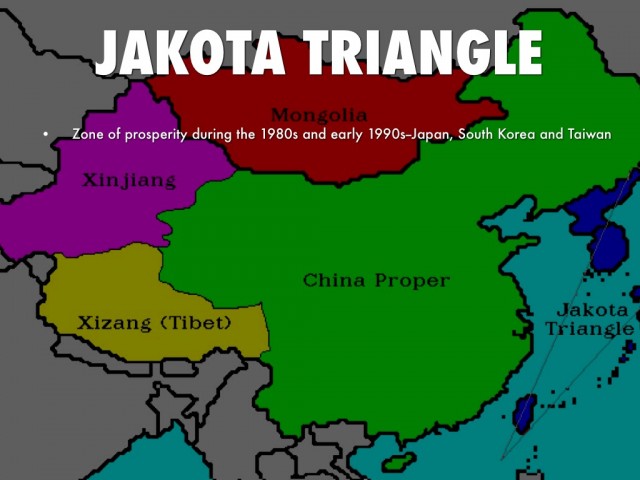Jakota Triangle
THE JAKOTA TRIANGLE is an East Asian region comprising three countries: JAPAN, SOUTH KOREA, and TAIWAN. The concept originated with Harm de Blij and it has become popularized in the many editions of Geography: Realms, Regions and Concepts, first appearing in the 8th edition, published in 1997. The term triangle was inspired by the three-sided figure defined by the three capital cities of the region: TOKYO, Seoul and Taipei. But the Jakota triangle is unified by more than its three-cornered geometry. This group of East Asian states shares high population density, a high level of urbanization, rapid growth in manufacturing in spite of its dependence on imported raw materials, and lingering geopolitical problems that may be traced to the end of World War II.

The Jakota Triangle is distinctive for its high average population density. Yet each of the three member countries has a rugged and sparsely settled interior: Japan's 60 active volcanoes are legendary, most notable of which is Mount Fuji, a snow-capped stratovolcano rising to 12,388 ft (3,776 m). The eastern side of the Korean peninsula is dominated by the desolate spine formed by the Taebaek Mountains (Taebaek Sanmaek), just as the most conspicuous physiographic feature of eastern Taiwan is the Chungyang Mountains, which rise to 13,114 ft (3,997 m) at Yu Shan (also known as Mount Morrison). Thus the population distribution of the Jakota countries is uneven with extremely high densities along fertile coastal plains and river valleys and notable concentrations in massive rapidly growing cities.
The Jakota triangle countries have levels of urbanization ranging from 65 percent in Japan to 80 percent in Korea. This feature makes the region distinct from the remainder of East Asia and especially from China, which has less than 40 percent of its population in urban areas.
Tokyo, Seoul, and Taipei are massive primate cities; each is well over twice the size of the second largest urban center in the country and each accounts for about one-quarter of its nation's total population. Tokyo is the largest metropolitan area on the planet with a population of 35 million. Seoul is approaching megacity status with a population of 9.7 million, while Taiwan's capital is smaller with 6.5 million. The primate city dominance of the Jakota countries extends to their pivotal role as centers of political and financial power and leadership in industrial technology. The Jakota triangle countries are also distinguished by the massive size and rapid growth of their manufacturing sectors, energy-intensive heavy manufacturing such as primary iron and steel and shipbuilding, labor-intensive light manufacturing such as textiles and garments, and traditional handicrafts such as paper, wood, and
ceramic products. Just as notable has been the explosive growth in Jakota exports of manufactured goods. Japan is now the world's second-largest manufacturing economy (after the UNITED STATES), while South Korea ranks seventh and Taiwan is in twelfth place. These nations are globally competitive because they have developed leading-edge manufacturing technologies and have highly skilled workers, an extremely low-cost structure, and aggressively entrepreneurial firms that are striving for world dominance in their industrial specialties. But surprisingly the Jakota countries have achieved these industrial wonders with a modest resource base, and they remain highly dependent on imports of raw materials such as energy, minerals, agricultural commodities, and forest products.